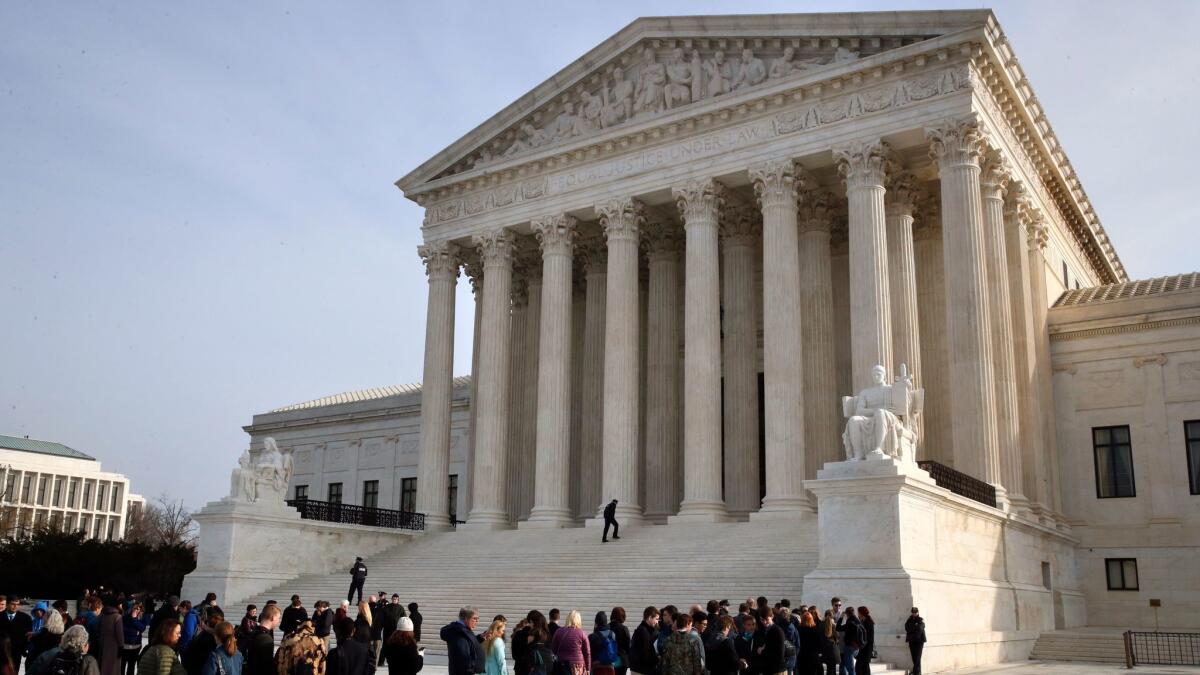Editorial: The Supreme Court has the chance to end the death penalty. They should take it

- Share via
There is no question that Abel Hidalgo has committed some awful crimes. As a gang member in Arizona, he accepted $1,000 in 2001 to murder auto repair shop owner Michael Cordova and also killed another man, Jose Rojas, who showed up at the shop at the wrong time. It took a year and an informant’s tip to lead police to Hidalgo, who by then was in federal prison for the drug-related murders of two women (one of them a former girlfriend) on a Native American reservation in Idaho.
Hidalgo is just the kind of person from whom society needs to be protected, and he should be locked away. Few would disagree about that. A more complicated question — even for those who support capital punishment — is whether an Arizona jury was right to sentence him to death.
The U.S. Supreme Court has held that states must design their capital punishment statutes so that only truly egregious crimes are punished by death. But Hidalgo argues that Arizona has added so many “aggravating circumstances” — factors that turn a run-of-the-mill killing into a capital crime — that pretty much any murder in Arizona can now qualify for the death penalty.
The Times opposes the the death penalty under all circumstances.
Hidalgo’s argument circles back to two key Supreme Court decisions in the 1970s. The 1972 Furman decision struck down the death penalty entirely on the grounds that it was being applied so arbitrarily that it violated the 8th Amendment’s prohibition against “cruel and unusual punishments.” States then began rewriting their death statutes to try to reduce their arbitrary application, and in 1976 the court ruled that the death penalty could resume in states with statutes limiting the death penalty to particularly atrocious crimes.
Now Hidalgo argues that Arizona’s list of death-eligible crimes is so expansive that it’s entire capital punishment system is unconstitutional, and he has a point. If nearly every murder can be eligible for a death sentence, then the system has swung back to arbitrariness — leaving the decision whether to seek capital punishment up to the whims of prosecutors, and its application to juries. On that, Arizona shares some common ground with California, which has three dozen “special circumstances” that can make a murderer subject to the death penalty.
The Times opposes the the death penalty under all circumstances. We take a “Green Eggs and Ham” approach — we don’t like it here, there or anywhere. But if states are going to engage in such a barbaric practice, they must at least follow the Constitution, and we hope the Supreme Court accepts the case and, at the very least, strikes down such broad definitions of death-eligible crimes.
But Hidalgo raises another, even more challenging issue and could conceivably lead to an even more radical decision. The death penalty, Hidalgo argues, is inherently unconstitutional because the nation has been unable to use it without descending into an unreliable system in which the poor and minorities are disproportionately affected, and too many innocent people have been sentenced to death. (There have been 117 death row exonerations since 1989.) The problems with the convictions range from prosecutorial misconduct to erroneous witness identifications to confessions gained through coercion or by playing on the inadequacies of the intellectually disabled. Exonerations often don’t come until years after conviction. Meanwhile, executions often occur so long after the underlying crime was committed that they serve no penological purpose. So far this year, 23 people have been executed after spending an average of 19½ years on death row.
Justice Stephen G. Breyer invited this sort of review in his dissent in the 2015 Glossip decision upholding use of the drug midazolam in lethal injections. “Rather than try to patch up the death penalty’s legal wounds one at a time,” he wrote, “I would ask for full briefing on a more basic question: whether the death penalty violates the Constitution.” Whether Hidalgo’s case is the one that will finally get the court to recognize the fatal flaws in the death penalty is hard to say. But we hope so. It’s a medieval system too fraught with human error to be relied upon for determining whether someone should live or die.
Follow the Opinion section on Twitter @latimesopinion or Facebook
More to Read
A cure for the common opinion
Get thought-provoking perspectives with our weekly newsletter.
You may occasionally receive promotional content from the Los Angeles Times.










